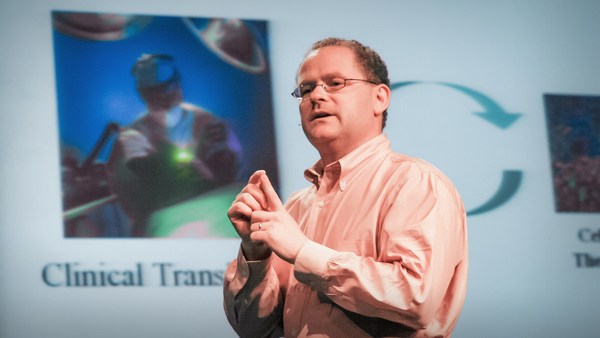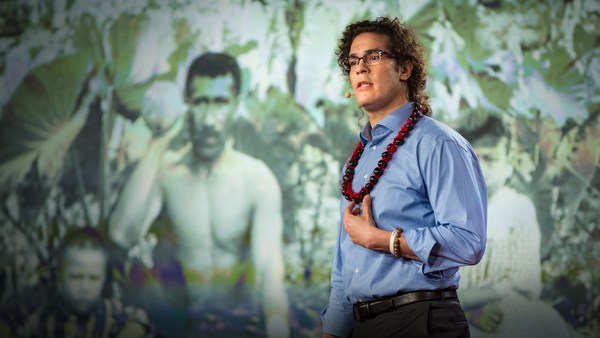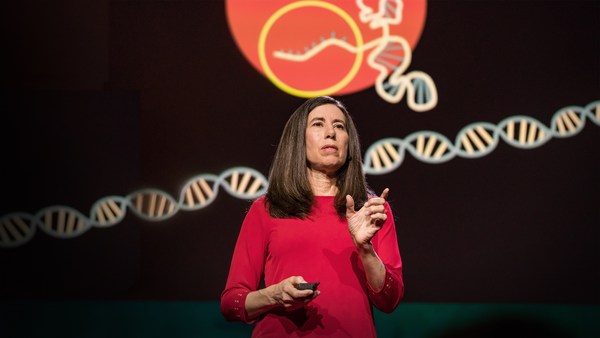Ladies and gentlemen, I present to you the human genome.
(Applause)
Chromosome one -- top left, bottom right -- are the sex chromosomes. Women have two copies of that big X chromosome; men have the X and, of course, that small copy of the Y. Sorry boys, but it's just a tiny little thing that makes you different. So if you zoom in on this genome, then what you see, of course, is this double-helix structure -- the code of life spelled out with these four biochemical letters, or we call them bases: A, C, G and T. How many are there in the human genome? Three billion. Is that a big number? Well, everybody can throw around big numbers. But in fact, if I were to place one base on each pixel of this 1280x800-resolution screen, we would need 3,000 screens to take a look at the genome. So it's really quite big.
And perhaps because of its size, a group of people -- all, by the way, with Y chromosomes -- decided they would want to sequence it.
(Laughter)
And so 15 years, actually, and about four billion dollars later, the genome was sequenced and published. In 2003, the final version was published, and they keep working on it. That was all done on a machine like this. It costs about a dollar for each base -- a very slow way of doing it.
Well, folks, I'm here to tell you that the world has completely changed, and none of you know about it. So now what we do is take a genome, we make maybe 50 copies of it, we cut all those copies up into little 50-base reads, and then we sequence them, massively parallel. Then we bring that into software and reassemble it, and tell you what the story is. So to give you a picture of what this looks like, the Human Genome Project: 3 gigabases, right? One run on one of these modern machines: 200 gigabases in a week. And that 200 is going to change to 600 this summer, and there's no sign of this pace slowing. The price of a base, to sequence a base, has fallen 100 million times. That's the equivalent of you filling up your car with gas in 1998, waiting until 2011, and now you can drive to Jupiter and back twice.
(Laughter)
World population, PC placements, the archive of all of medical literature, Moore's law, the old way of sequencing, and here's all the new stuff. Guys, this is a long scale; you don't typically see lines that go up like that. So the worldwide capacity to sequence human genomes is something like 50,000 to 100,000 human genomes this year. We know this based on the machines that are being placed. This is expected to double, triple or maybe quadruple year over year for the foreseeable future. In fact, there's one lab in particular that represents 20 percent of all that capacity: It's called the Beijing Genomics Institute. The Chinese are absolutely winning this race to the new Moon, by the way. What does this mean for medicine?
So a woman, age 37, presents with stage 2 estrogen receptor-positive breast cancer. She is treated with surgery, chemotherapy and radiation. She goes home. Two years later, she comes back with stage 3C ovarian cancer, unfortunately; treated again with surgery and chemotherapy. She comes back three years later at age 42 with more ovarian cancer, more chemotherapy. Six months later, she comes back with acute myeloid leukemia. She goes into respiratory failure and dies eight days later.
So first: the way in which this woman was treated, in as little as 10 years, will look like bloodletting. And it's because of people like my colleague, Rick Wilson, at the Genome Institute at Washington University, who decided to take a look at this woman postmortem. And he took skin cells, healthy skin and cancerous bone marrow, and sequenced the whole genomes of both of them in a couple of weeks, no big deal. Then he compared those two genomes in software, and what he found, among other things, was a deletion -- a 2,000-base deletion across three billion bases in a particular gene called TP53. If you have this deleterious mutation in this gene, you're 90 percent likely to get cancer in your life.
So unfortunately, this doesn't help this woman, but it does have severe -- profound, if you will -- implications to her family. I mean, if they have the same mutation, and they get this genetic test and they understand it, then they can get regular screens and can catch cancer early, and potentially live a significantly longer life.
Let me introduce you to the Beery twins, diagnosed with cerebral palsy at the age of two. Their mom is a very brave woman who didn't believe it; the symptoms weren't matching up. And through some heroic efforts and a lot of Internet searching, she was able to convince the medical community that, in fact, they had something else. They had dopa-responsive dystonia. And so they were given L-Dopa, and their symptoms did improve, but they weren't totally asymptomatic. Significant problems remained.
Turns out the gentleman in this picture is a guy named Joe Beery, who was lucky enough to be the CIO of a company called Life Technologies. They're one of two companies that makes these massive whole-genome sequencing tools. And so he got his kids sequenced. What they found was a series of mutations in a gene called SPR, which is responsible for producing serotonin, among other things. So on top of L-Dopa, they gave these kids a serotonin precursor drug, and they're effectively normal now. Guys, this would never have happened without whole-genome sequencing. At the time -- this was a few years ago -- it cost $100,000. Today it's $10,000, next year, $1,000, the year after, $100, give or take a year. That's how fast this is moving.
So here's little Nick -- likes Batman and squirt guns. And it turns out Nick shows up at the children's hospital with this distended belly, like a famine victim. And it's not that he's not eating; it's that when he eats, his intestine basically opens up and feces spill out into his gut. So a hundred surgeries later, he looks at his mom and says, "Mom, please pray for me. I'm in so much pain." His pediatrician happens to have a background in clinical genetics and he has no idea what's going on, but he says, "Let's get this kid's genome sequenced." And what they find is a single-point mutation in a gene responsible for controlling programmed cell death. So the theory is that he's having some immunological reaction to what's going on -- to the food, essentially. And that's a natural reaction, which causes some programmed cell death, but the gene that regulates that down is broken. And so this informs, among other things, of course, a treatment for bone marrow transplant, which he undertakes. And after nine months of grueling recovery, he's now eating steak with A1 sauce.
(Laughter)
The prospect of using the genome as a universal diagnostic is upon us today. Today. It's here. And what it means for all of us is that everybody in this room could live an extra 5, 10, 20 years, just because of this one thing. Which is a fantastic story, unless you think about humanity's footprint on the planet, and our ability to keep up food production. So it turns out that the very same technology is also being used to grow new lines of corn, wheat, soybean and other crops that are highly tolerant of drought, of flood, of pests and pesticides. Now, look -- as long as we continue to increase the population, we'll have to continue to grow and eat genetically modified foods. And that's the only position I'll take today. Unless there's anybody in the audience who'd like to volunteer to stop eating? None, not one.
This is a typewriter, a staple of every desktop for decades. And, in fact, the typewriter was essentially deleted by this thing. And then more general versions of word processors came about. But ultimately, it was a disruption on top of a disruption. It was Bob Metcalfe inventing the Ethernet, and the connection of all these computers that fundamentally changed everything. Suddenly we had Netscape, we had Yahoo. And we had, indeed, the entire dot-com bubble.
(Laughter)
Not to worry though, that was quickly rescued by the iPod, Facebook and, indeed, Angry Birds.
(Laughter)
Look, this is where we are today. This is the genomic revolution today. This is where we are. What I'd like you to consider is: What does it mean when these dots don't represent the individual bases of your genome, but they connect to genomes all across the planet? I just recently had to buy life insurance, and I was required to answer: A. I have never had a genetic test; B. I've had one, here you go; or C. I've had one and I'm not telling. Thankfully, I was able to answer A, and I say that honestly, in case my life insurance agent is listening. But what would have happened if I had said C?
Consumer applications for genomics will flourish. Do you want to see if you're genetically compatible with your girlfriend? DNA sequencing on your iPhone? There's an app for that.
(Laughter)
Personalized genomic massage, anyone? There's already a lab today that tests for allele 334 of the AVPR1 gene, the so-called cheating gene.
(Laughter)
So anybody who's here today with your significant other, just turn over to them, swab their mouth, send it to the lab and you'll know for sure.
(Laughter)
Do you really want to elect a president whose genome suggests cardiomyopathy? Think of it -- it's 2016, and the leading candidate releases not only her four years of back-tax returns, but also her personal genome. And it looks really good. Then she challenges all her competitors to do the same. Do you think that's not going to happen? Do you think it would have helped John McCain?
(Laughter)
How many people in the audience have the last name Resnick, like me? Raise your hand. Anybody? Nobody. Typically, there's one or two. So my father's father was one of 10 Resnick brothers. They all hated each other, and all moved to different parts of the planet. So it's likely I'm related to every Resnick that I ever meet, but I don't know. So imagine if my genome were De-identified, sitting in software, And a third cousin's genome was also sitting there, and there was software that could compare the two and make these associations. Not hard to imagine. My company has software that does this right now. Imagine one more thing, that that software is able to ask both parties for mutual consent: "Would you be willing to meet your third cousin?" And if we both say yes -- voilà! Welcome to Chromosomally LinkedIn.
(Laughter)
Now this is probably a good thing, right? Bigger clan gatherings and so on. But maybe it's a bad thing as well. How many fathers in the room? Raise your hands. OK, so experts think that one to three percent of you are not actually the father of your child.
(Laughter)
Look --
(Laughter)
These genomes, these 23 chromosomes, they don't in any way represent the quality of our relationships or the nature of our society -- at least not yet. And like any new technology, it's really in humanity's hands to wield it for the betterment of mankind or not. And so I urge you all to wake up and to tune in and to influence the genomic revolution that's happening all around you.
Thank you.
(Applause)





